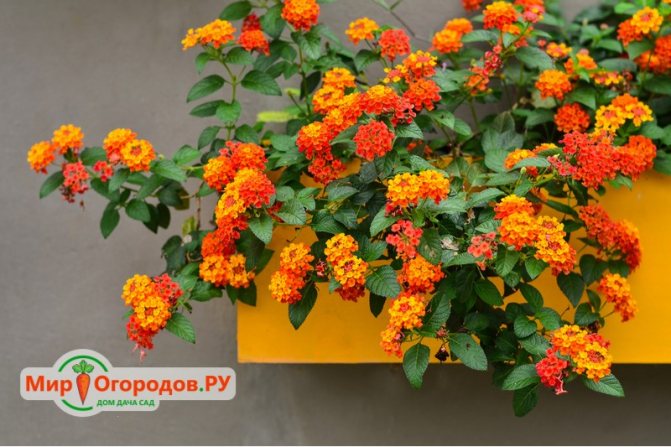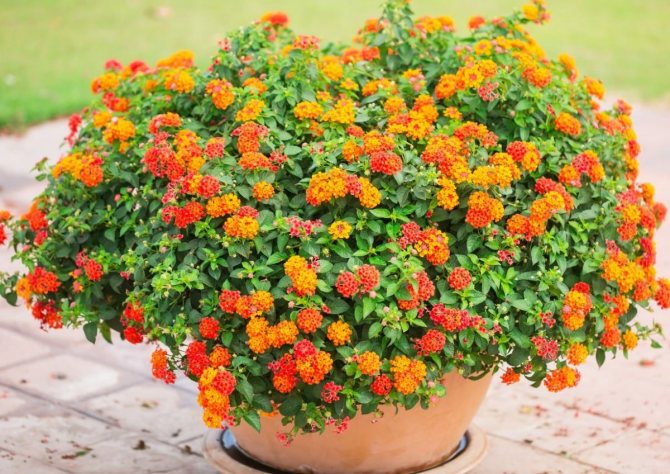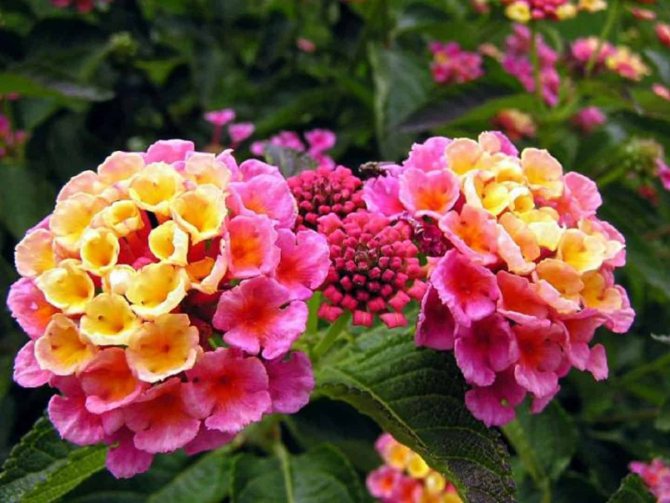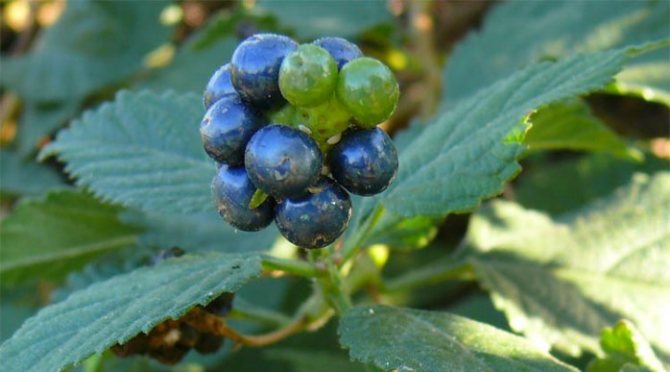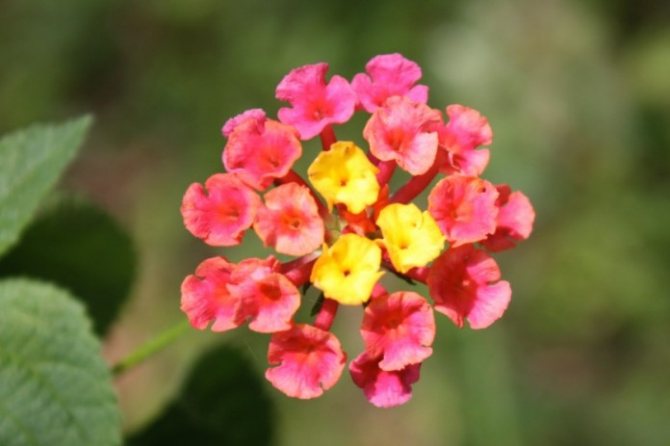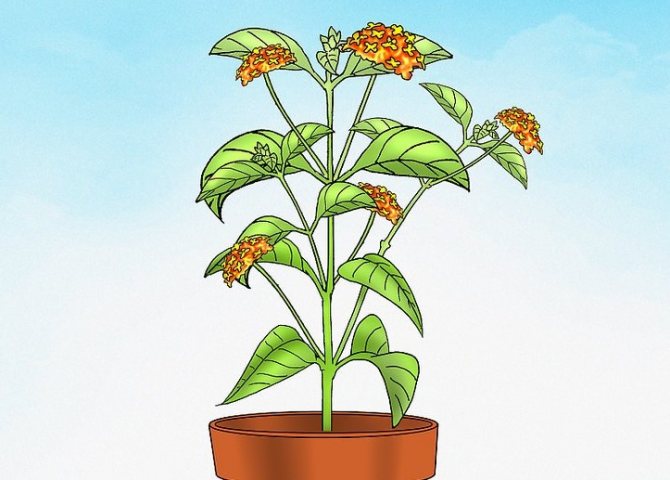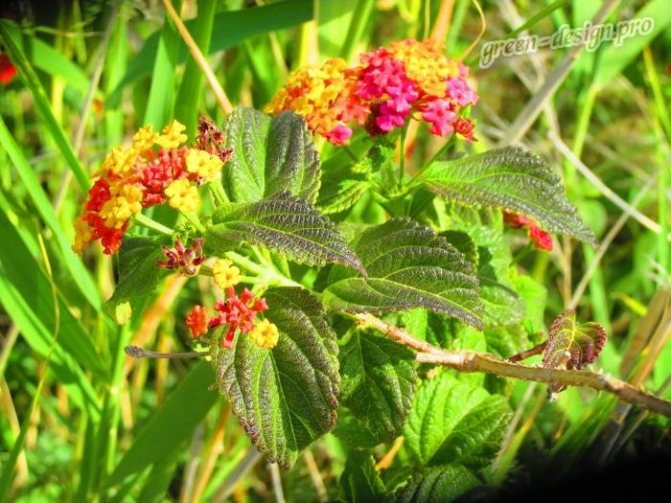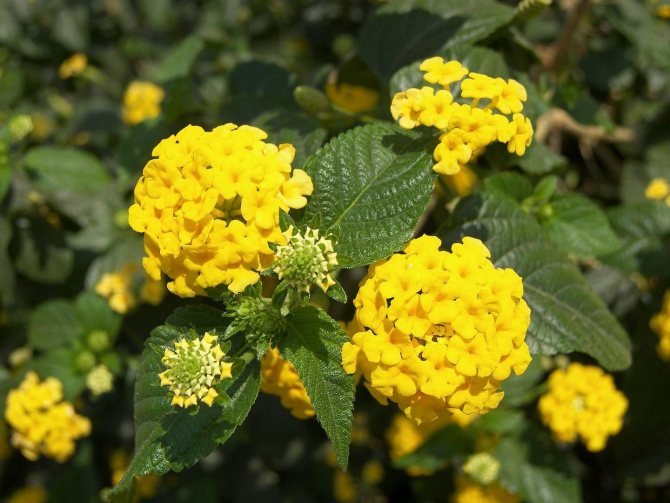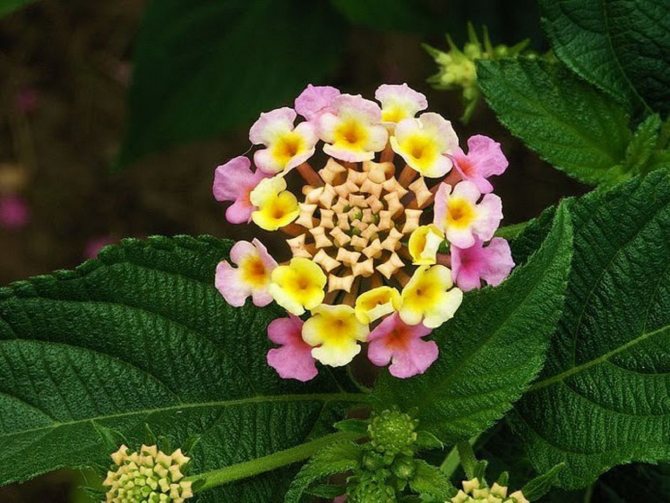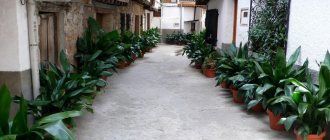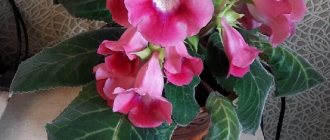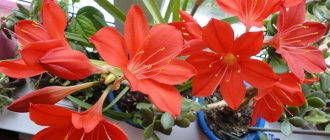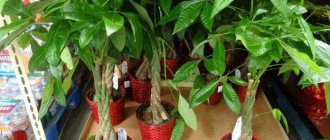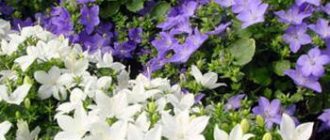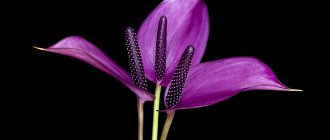Do-it-yourself beautiful and productive beds
Home ›Flowers› Flower "Lantana": description, photo, cultivation and care at home
Lantana - This sunny flower is eye-catching. The bright flowers and unusually colored leaves of this native of the tropics will look extremely good both in the garden on the flower bed and at home on the windowsill.
The flower can quickly adapt to home living conditions, which compares favorably with other potted plants.
The plant can be in the form of a bush, a small tree or an ampelous flower. During flowering, lantana is able to change the color of flowers.
Lantana belongs to the Verbenov family. This is a very beautiful perennial flower. The habitat of lantana is the subtropics of India, Colombia, Mexico.
The plant feels great in Central Asia and the Mediterranean. These unpretentious bushes delight with abundant flowering all summer. It is very surprising, but their inflorescences in the form of balls change color during flowering. Yesterday, the still white flowers turn pale pink.
Breeding this actively growing and flowering bush does not require much effort and hassle.
Botanical description
The lantana flower belongs to the Verbenaceae family. The plant is well suited to a subtropical climate, so it most often lives in Mexico, Colombia and India. But they learned to grow it in other countries. This flower is easily adaptable to life at home.
In appearance, lantana is a shrub with erect stems, on which spreading branches are formed. The size of the plant depends on the growing conditions. If caring for it is carried out correctly, then the bush quickly increases in size and can reach a height of 3 m. But there are varieties that are characterized by slow growth and small size in adult form.
Lantana branches are covered with light green bark, in some species they may have thorns. The leaves are small, no more than 5 cm in diameter. They are bright green in color and ovoid with jagged edges.
The plant blooms in small inflorescences that can change color during the growing season. At first, the flowers are yellow or white, then they turn pink and deeply scarlet. They are characterized by an intense aroma.
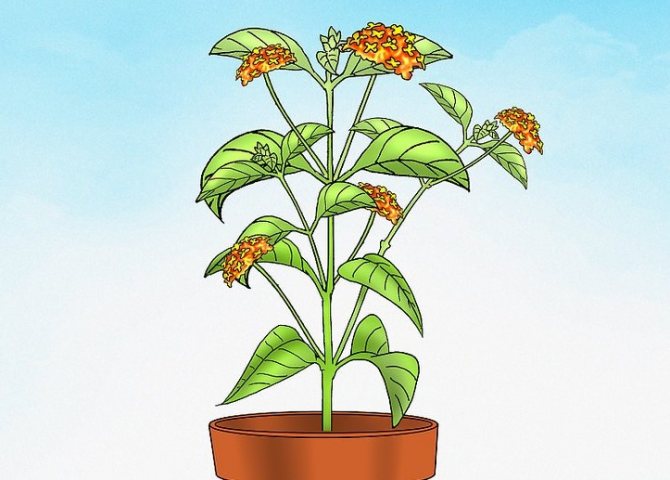
Growing a plant
Growing the lantana kamara plant at home, it is required to recreate the most accurate conditions for picking a flower at home. Since it is a tropical plant, and in the forests of Brazil, it could grow up to two meters in height, growing in such a way that it is extremely difficult to pass through it. It grows best on forest edges, sunny areas and near rivers. In summer, lanthanum is comfortable with high temperature and humidity. For winter, you need to create certain conditions for the plant, it is a well-lit window sill, humidity is within normal limits and air temperature, which should not exceed ten degrees. After the flower has overwintered, stood, it must be planted in a new pot and cut off. When choosing a soil for a plant, it is important to know that highly fertile soils for a flower are not suitable, because there is a very weak flowering in them. A mixture of leaf humus and sand should be added to a new pot.
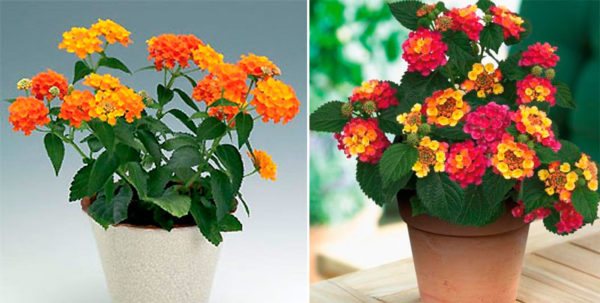

Varieties
There are the following types of lanthanum:
- Thorny, otherwise - vaulted (Lantana camara). It is an erect shrub, the height of which can reach one and a half meters. The stems are covered with thorns, which is why the name of the plant arose. During the flowering period, the bush is covered with yellow or pink inflorescences. In the future, the color changes to scarlet and peach, respectively. The diameter of the flowers reaches 5 cm.
- Sello (Selloviana). Plants are characterized by slender and flexible stems. The bush forms small flowers with a bright yellow base and mauve tips. Their size is about 5 mm. The leaves of this lantana are dark green and pubescent on the underside.
- Montevidensis. This variety is distinguished by climbing shoots covered with small leaves. The color of the inflorescences is lavender or purple. Their diameter does not exceed 3 cm.
- Wrinkled (Rugulosa). The name of the plant comes from its shriveled and rough leaves. An adult shrub can reach a height of one meter. It is distinguished by straight shoots in small thorns. The flowers have a light purple color.
- Sage (Salviifolia). The height of such a plant can be up to 2 meters. Its stems are intensively branching. Veins are clearly visible on the dark green leaves. The color of the buds can be pale pink or light purple.
- Blood red (Sanguinea). This variety is characterized by solid orange-red inflorescences. The size of the shrub reaches one and a half meters. The branches are covered with large oval-shaped leaves.
- Hybrid (Hybrida). Lantana of this type can grow up to 80 cm. It has wrinkled leaves and flowers of a lemon-yellow hue, which later becomes red-orange.
For decorative purposes, hybrid plant varieties are used. Many of them were bred from the thorny lantana (camara).
The most popular of the lantana varieties in the photo:
- White Dwarf. A feature of the variety is the white flowers.
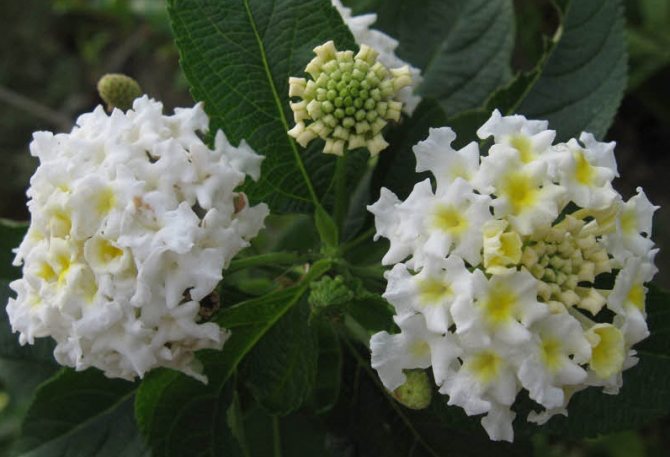

- Tutti Frutti. The inflorescences of such lantana are first yellow, then orange, and then purple.


- Esperanta Pink. The shrub is characterized by mauve flowers.
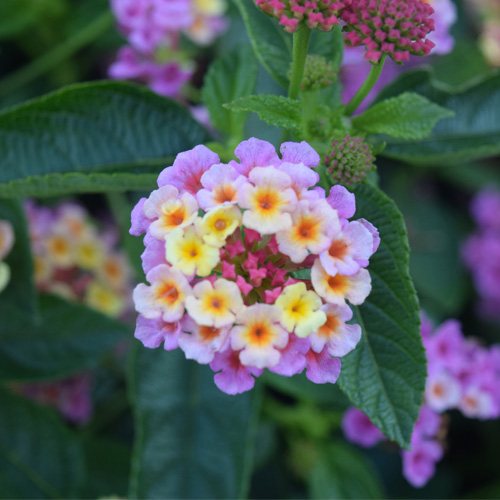

- Bandana Pink. The petals of this variety are pink or crimson.


- Kamara Lyubava. Quite tall shrub (up to 150 cm) with pubescent tetrahedral stems and gray-green foliage. Inflorescences - from orange to reddish.
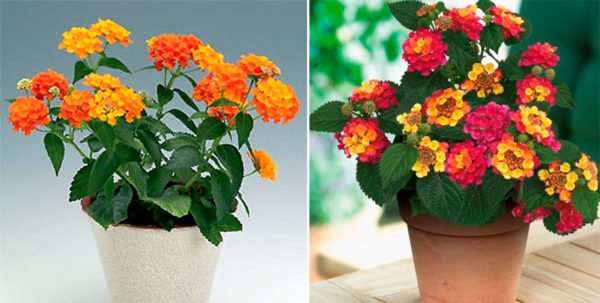

Almost all hybrid varieties are characterized by slow growth rates and compact size. The height of mature plants varies from 50 to 80 cm.
Reproduction of lantana
Lantana camara reproduces in two ways, this is blackening and the seed version. When receiving a new plant through a cutting, you should:
- Prepare the cuttings, which should be half woody. The heel should be at least ten centimeters in size on the handle. Cuttings are harvested at the end of winter, at the beginning of spring, this is the period when the main plant is pruned.
- The leaves located at the bottom are removed from the cutting, after which it is placed in loose soil, which will need to be constantly moistened.
- In order for the cutting to quickly take root, it is best to make greenhouse conditions for it by covering it with a film or a plastic bottle.
- At first, the stalk is grown in a warm temperature regime, when the room is twenty degrees Celsius. A month later, the amount of heat begins to decrease and is brought to twelve degrees above zero.
- As soon as the first shoots appear, you need to pinch the side branches to form the future bush.
There are some varieties of lantana that are grown from seeds. These seeds are sold in specialty stores. In order to get the lantana camara plant from seeds, you need:
- Before planting seeds, they should be steamed with a thermos.This procedure is carried out within two hours. The seeds are then placed in a solution that stimulates growth.
- After the preliminary germination measures have been taken, the seeds are spread in the soil and covered with a film.
- The leaves of the plant appear no earlier than a month later, and this despite the fact that the air temperature and humidity should be increased.
- It is necessary to plant lantana when at least four leaves grow in it.
If the summer is warm, the plant can be planted in a flower bed, however, it should be remembered that lantana survives all the plants next to it. With such a summer life cycle, the plant sheds its leaves by autumn and may disappear altogether. The plant must be planted in a tub, pruned and placed in a cool place.
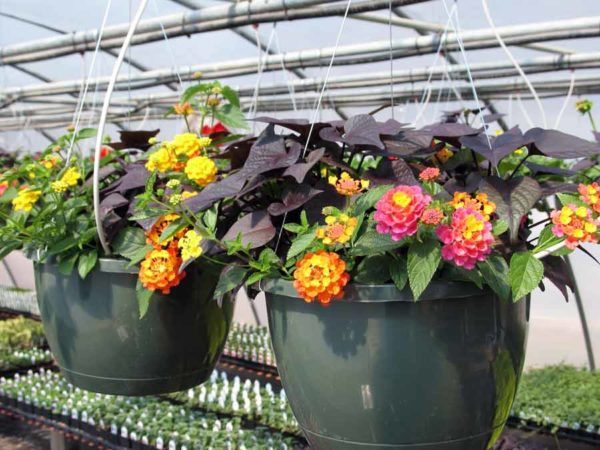

Reproduction methods
The main methods of reproduction of lantana are cuttings and cultivation from seeds.
Cutting is an easier method for propagating lantana. In this case, during spring pruning, cuttings with four leaves are separated. Each piece should be about 10 cm long.
For rooting, cuttings are placed in loose soil rich in nutrients for rooting. Then they are planted in a lighted area. The first 2 weeks the seedlings should be covered with plastic wrap. For another week, the film is removed for several hours in a warm time of the day and returned to the place at night. Then the plants can be opened completely.
The advantage of cuttings is the preservation of the characteristics of the mother flower, which does not always happen when planting seeds.
Reproduction of lantana by cuttings:
The second method requires a lot of effort, but in this case it is possible to grow more new plants.
In most cases, growing lanthanum from seeds is best done with the Kamara Lyubava variety - they are most often found on the market. But if necessary, you can find other varieties.
Seeds are planted in November. Before starting work, you need to immerse them in hot water for 2 hours. Then they are supposed to be treated with a preparation to stimulate growth, after which the seeds can be immersed in the soil of peat and sand.
The container is covered with foil and placed in a warm place. The optimal temperature indicator is about 22 degrees.
The first shoots should appear in about 3 weeks. They no longer need heat so much, so the growing temperature can be lowered to 14 degrees. For seedlings to grow faster, they should be highlighted.
Seedlings are transplanted into separate containers after 2-3 leaves are formed.


Caring for lantana camara at home
Taking care of this unique herb is not difficult at all, but maintenance procedures should be regular. Standard watering, top dressing, and other points of care in combination with mandatory hygienic procedures - that's all the plant needs.
Watering and air humidity
The main task when caring for lanthanum is to prevent the substrate from completely drying out. This plant does not tolerate dampness, but if watering is skipped and the earthy coma is allowed to dry, lantana will begin to shed the lower leaves.
Water the plant, allowing the upper part of the substrate to dry out, but trying to maintain a stable moisture content. The plant is not afraid of abundant watering, but it is better to drain the water from the pallets 20-30 minutes after watering.
During the winter, the watering of lantana kamara is reduced several times, trying to maintain a very light soil moisture. If the plants hibernate in the cool, you need to be very careful with watering, and when dropping leaves in the warmth, they are carried out only to maintain the viability of the roots. The water should be soft and warm.
Outside the flowering period, lanthanas can be sprayed, but they also tolerate dry air well. But it is imperative to keep the leaves clean, carefully removing dust from them.
Top dressing and composition of fertilizers
Despite its rapid growth and rather rapid depletion of the soil, lantana does not tolerate too abundant feeding. Even if you use a strategy that is standard for garden tubs or flowering potted plants, there is a risk of creating the effect of excessive fertilizing and stimulating the growth of leaves to the detriment of flowering.
For lantana, fertilizers are applied regularly, from March until the end of flowering, with the usual frequency of 1 every 2 weeks, but the concentration of dressings is reduced by 2 times compared to the manufacturer's instructions. It is undesirable to make top dressing ordinary, but rare, because this way the plant will grow in less stable conditions with differences in soil nutrient values.
For lantana, despite its status as a flowering crop, fertilizers specially formulated to stimulate flowering are not suitable. This crop prefers complex balanced fertilizers with an equal content of all three macronutrients. Only in the period of preparation for flowering at the budding stage can potash-phosphorus fertilizers be applied.
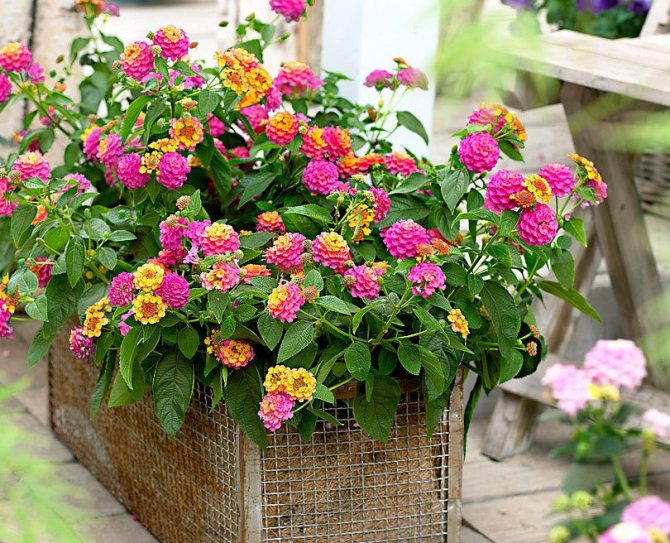

Lantana Camara Lucky Sunrise. <>
Pruning and shaping lantana camara
Lantana camara blooms only on young, one-year-old shoots that have not yet begun to wood, and haircut, regular pruning only stimulates more abundant flowering.
This is a unique plant that is cut regularly in summer, at least 2-3 times, stimulating both tillering and flowering. For lantana, pruning is carried out at the end of winter or before transplanting, repeating regulating haircuts or slightly shortening the shoots up to 4-5 times per season.
Formation during the first two years is of critical importance for all species of lanthanum - when the plant is given the shape of a tree and a bush, which is only supported from the third year. You can shorten the shoots of lantana according to the desired contour or size, leaving at least 1-2 pairs of leaves on the branches. Both a strong haircut and a light pinching of the tops of lanthanum endure equally well.
If lantanas winter in the warmth or begin to lose their decorative effect and require rejuvenation, they carry out a radical pruning, leaving only the lower buds on the branches, and where the old shoots are strongly stretched out, cutting off the lignified shoots. Such lanthanas require a mandatory transplant.
Lantanas, despite the rapid flowering and seemingly difficult to restrain growth, are one of the best candidates for indoor topiary. The crown of a plant can be carefully, carefully cut in a certain shape, most often - emphasizing the natural density and spherical silhouettes.
Neat and elegant balls on boles can become a small miracle in containers. Especially often, according to the strict canon, those lantanas that are grown as indoor-garden or garden with wintering indoors are cut.
Lantana can be grown as a standard plant, and the stem is surprisingly easy to form. To transform the rainbow nettle into a tree, it is enough not to touch the central shoot until it grows to a height of more than 60 cm, and remove only all lateral branches, leaving the base of the shoot "naked" to a height of 30-50 cm. Above 50 cm, the "trunk »Lanthanum should not be driven out, longer legs will not allow the plant to remain resistant.
Transplant, containers and substrate
Lantana camara grows very quickly and just as rapidly assimilates the available soil. The rapid development of both the aerial part and the rhizome requires regular transplantation. Despite the fact that, like any other tub, lantana is best transplanted as needed, it is usually transshipped annually. Only plants in a neglected state or formed into strict stems do not have time to master the entire substrate in a year.
Usually, due to the lack of space for the development of roots and the depletion of the soil of lantana, camaras stop blooming. If the transplant is not carried out, it is still necessary for the plant to replace the topsoil with a fresh nutrient substrate.
For lantana, be sure to select large, spacious, deep containers with good drainage holes.
Loose and nutritious soil mixtures are preferred for this crop, but not overly fertile soils. Lantana depletes any substrate quite quickly, but excessive fertility impairs flowering and stimulates rapid growth, but the choice of a medium or poorly nutritious substrate allows you to better restrain the plant and increase flowering.
For lantana camara, simple earth mixtures of leafy earth with sand in equal parts or substrates consisting of sod, leafy soil, peat and sand with a dominance of soddy soil are suitable. When choosing purchased substrates, soil mixtures with a complex composition are used and an additional portion of loosening components must be added.
Transplanting is usually carried out in the form of transplanting with shortening of the roots after reaching the maximum volumes of containers. A high drainage layer is laid at the bottom of the tanks.
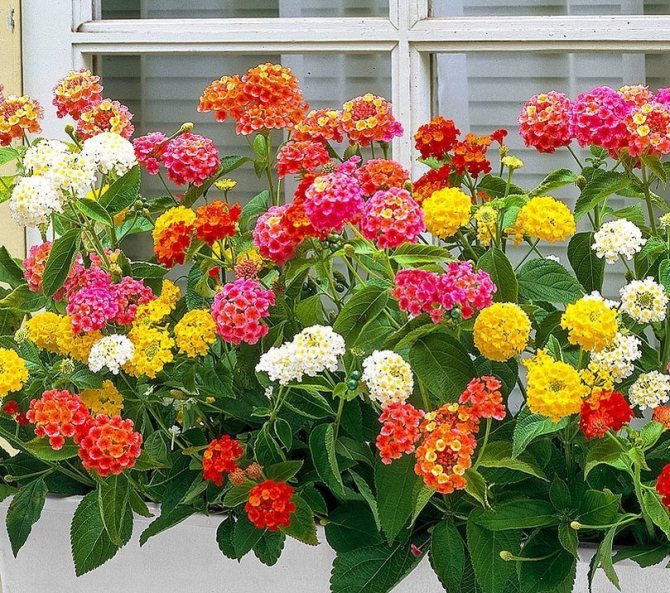

The best breeding method for camara lantana is called cuttings. <>
Transplanting and growing
Lantana is transplanted in the spring. While the flower is actively developing, it should be replanted annually so that there is room for the formation of the root system. Aging shrubs can be replanted every 3 years.
It is supposed to make a transplant in early spring. Each time it is recommended to take containers of a slightly larger volume than they were before.
Expanded clay or pebbles must be laid at the bottom of the container to avoid stagnant water, otherwise this may affect the condition of the plant. The soil is prepared from several components: humus, river sand, sod and leafy soil. It should allow air to pass through well.
During transplantation, it is supposed to remove part of the earthen coma so that the plant gains access to new soil rich in minerals.
Caring for lantana at home requires adherence to the following rules:
- Adequate amount of light. This shrub prefers well-lit areas, so it should be located on the south side. In the summertime, it can be taken out into the garden.
- Avoiding shady areas. Lantana is comfortable staying in direct sunlight. In the shade, its leaves become smaller and fewer flowers are formed.
- Heat. The plant prefers a hot climate. In such conditions, it develops rapidly and blooms profusely. But then he needs frequent watering. The optimum air temperature for growing is from 22 to 27 degrees. In winter, it should not drop below 10 degrees. Only a few varieties of lanthanum are able to withstand small and short-term frosts.
- Air humidity. It is not necessary to artificially increase the humidity of the air. Normal home conditions are suitable for the shrub. But the culture reacts positively to spraying the leaves. But you must not allow water to fall on the inflorescences.
- Regular watering. The soil should not dry out - this leads to the cessation of growth. Plants should be watered with warm, settled water.
- Top dressing. Fertilizers are supposed to be applied during the growing season, using complex preparations twice a month.
To give the plant a beautiful shape, it is recommended to cut the bush and pinch it. So it is possible to improve the decorative qualities and make the crown lush.
Transfer
Lantana grows pretty quickly. The developing root system requires transplanting at the beginning every year, and as it ages, every three years.
The best time to transplant is early spring. The container for the plant is chosen deep enough and roomy. With subsequent transplants, the pot must be taken a couple of centimeters larger than the previous one. In this case, the roots, being in a small volume, will stimulate flowering.
The bottom must be drained with pebbles, expanded clay or other suitable material. Lantana does not tolerate excessive stagnation of water in a pot.Waterlogged soil becomes the cause of various diseases in the plant.
The soil for the flower must be selected breathable, consisting of:
- 4 pieces of leafy land;
- 3 parts of sod land;
- 1 part of humus earth;
- 1 part river sand.
When transplanting a plant, it is necessary to remove part of the old earthen coma. This will provide better plant nutrition from more nutrient-rich new soil.
Description
A sprawling shrub, reaching impressive sizes in its hot homeland, is appreciated by flower growers for its abundant and long flowering. Lantana blooms from May to September, small fragrant flowers, collected in globular or corymbose inflorescences. The color of the petals in the natural forms of the plant can be white, pink, yellow, red, blue. Lantana has the ability to change the color of flower petals: freshly blossomed buds are yellowish, and later they become deep pink.
Lantana is grown as a pot culture, in the garden as an annual, since it cannot winter in our conditions.
You can appreciate the bright beauty of lantana by admiring the flower photo.


Lantana
Types and varieties
One of the most popular and well-known species is Lantana camara (vaulted), which has spiny stems and leaves pubescent below. In a pot culture, it forms a bush up to 50 cm in size. Inflorescences of bright flowers are formed in the leaf axils in late spring. Flowering continues until September.
Varieties:
- Golden cloud (bright golden flowers);


Golden cloud - Cocktail (flowers are yellow, orange and brick-colored);
- Naida (white flowers with a yellow droplet in the middle);
- Pink queen (yellowish-pink shade of petals, gradually turns into hot pink);
- Samantha (lemon flowers);
- A spreading sunset (the shape of the bush is spreading, the color of the buds is from yellow to red).
Montevideo lantana (selloviana) is a climbing plant with medium-sized ovoid pubescent leaves. The flowers are small, lilac with a pink tint and a yellow spot in the center. Blooms from June to November.
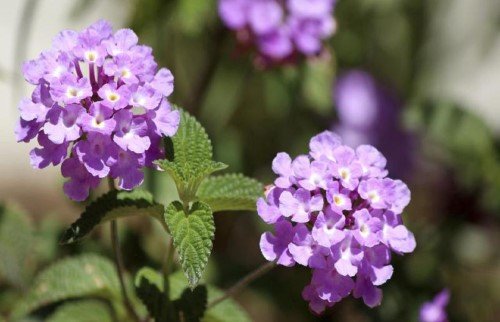

Montevideo
Lantana species
Of the existing 150 species of this plant, only two are used as an indoor flower.
Lantana Camara
Lantana Camara has small thorns on curly stems. The shape of the leaves is oval or heart-shaped, greenish-gray in color. The leaves themselves are hard, smooth on top, and on the inside covered with a short nap.
Inflorescence panicles, which form in leaf axils in May, are collected from small tubular flowers. The yellow or pink color of young buds gradually changes to red or orange. Because of this changeability, lantana is called a girlish word.
Lantana blooms all summer. Lantana fruit is poisonous!
Of the decorative varieties, the most popular are:
«Golden cloud"- with bright, yellow colors;
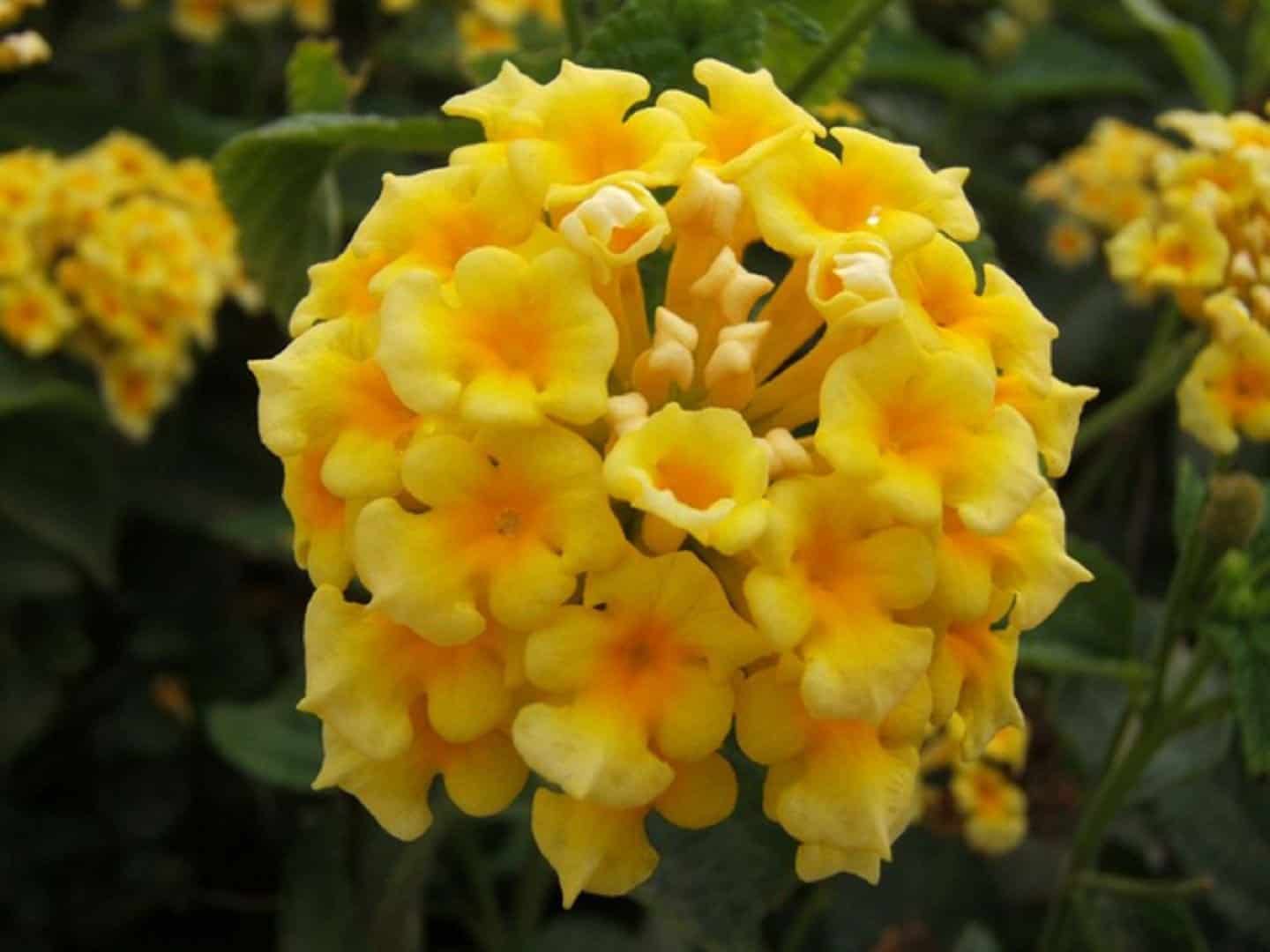

«Cocktail»- his flowers are orange and terracotta;
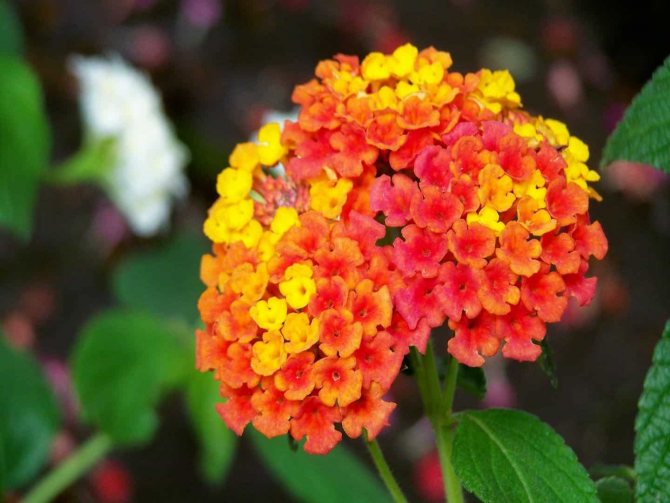

«Naida“- with snow-white buds with a coquettish yellow core inside;
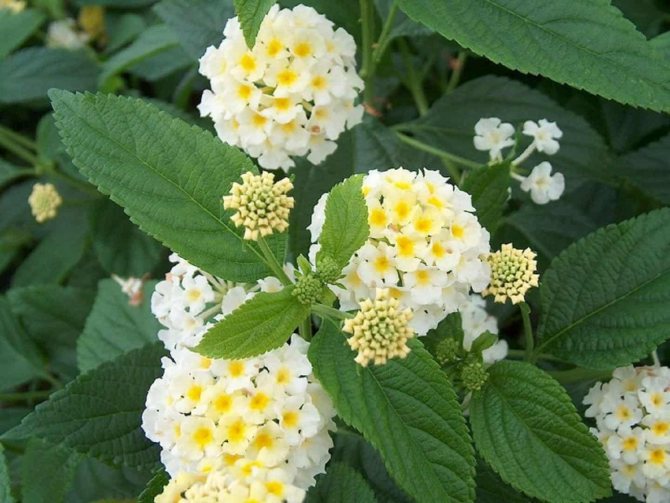

«Pink queen"- with caramel-yellow flowers, gradually changing color to doll-pink.
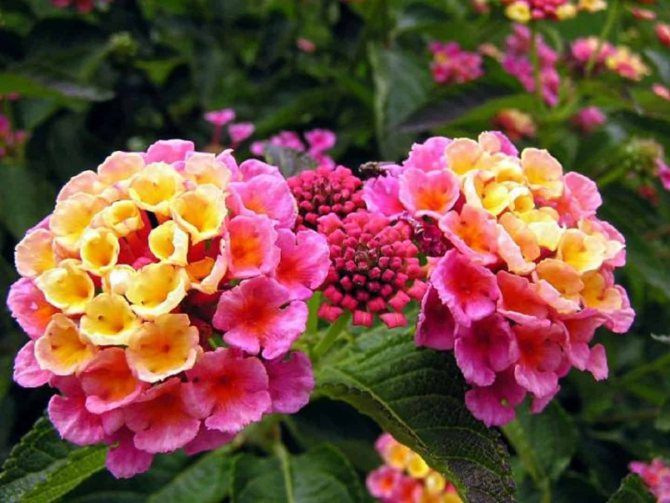

Lantana "Montevideo "... This species is not so popular, but it is also very attractive. The bright green leaves on the creeping branches are slightly inferior in size to other varieties, and the flowers in the inflorescence are made up of small, delicate lilac buds. Lantana begins to bloom in June and ends in October.


Growing conditions
The plant, although light-loving, put up with a lacy shadow. Lantana can be placed on the south, south-east and south-west balconies during the summer.
Finding the right lantana pot is important. It is good if it is of light colors, in such a container the roots of the plant will not overheat. The ceramic pot will also be comfortable for the plant due to its breathability. However, in a ceramic container, lanthanum will have to be watered more often.


A light pot is preferable
Summer comfortable temperature for lantana is +20 +25 degrees, the flower loves moist air, and needs spraying. For the winter, plants are brought into the room, and create comfortable conditions for a dormant period. This is an air temperature not higher than +12, dim lighting, poor watering, but spraying does not stop. Too dry indoor air weakens the plant. With the onset of spring, lantana twigs are cut by a third, thereby stimulating the growth of new shoots and tillering of the plant. The pruned twigs can be used to propagate the flower.
A soil mixture for lantana is prepared by mixing turf, sand and humus in equal parts. Up to 30% of high moor peat is added to this mixture, as it contributes to the moisture holding capacity of the soil.
Diseases, pests and problems in the cultivation of lantana camara
When partially grown in the open air and in a neglected state, lanthanum camara can suffer from rust, spotting, and non-specific wilting. The fight against any diseases on the plant is carried out immediately by treatment with a systemic fungicide. When the roots decay, lantana can be saved only by an emergency transplant.
Of the pests on this unique beauty, whitefly, spider mites and aphids are not uncommon. It is also better to start the fight against insects immediately with an insecticide treatment.
Any preventive and therapeutic measures on camara lanthanum should be combined with moving the plant to quarantine, correcting conditions and care, trimming severely damaged parts and maintaining impeccable cleanliness and leaves.
Lantana: how to grow, place in the country, its varieties and secrets
Interest in lantana as a room, tub and flower culture in open ground has increased significantly recently. The richness of colors of its small flowers, collected in rounded corymbose inflorescences, and, most importantly, a very long flowering, compact form when pinching the tops of shoots, unpretentiousness helped her to get into the top 10 of the best tub crops successfully grown today in southern Russia (see post Kadochnaya culture - expanding the boundaries of growing thermophilic woody plants). Therefore, as they say, there is a reason, and let's get to know lantana better, because it has not only a lot of advantages, but also its own "skeletons in the closet." Now, under the hybrid lantana (Lantana x hybrida), breeding and hybrid forms of vaulted, or prickly lantana are grown, and the Royal Society of Gardeners of Great Britain presents it as Lantana camara cultivars - I will adhere to this, too, relying on my desktop encyclopedia Encyclopedia of Garden Plants.
Short description
Before getting down to the main topic, I would like to tell you a little about this amazing plant. After all, not every day you see multi-colored inflorescences on one bush.
Morphological signs


- Belongs to the Verbena family. Under natural conditions, it can grow up to several meters. In temperate regions, it is grown as a pot plant (all year round) or as a garden plant (only in summer).
- The shrub is considered a tropical plant, in the wild it is found in the forests of Brazil, as well as in Turkey, Egypt, near water bodies, in open sunny places of hills and edges.
- The plant has several more names: lubava and lantana thorny. Indeed, the shrub has a strong stem with 4 edges and a thorny surface.
- The leaves are heart-shaped, with jagged edges and a rough top surface. The lower one is covered with a small downy. The veins are clearly traced on the leaf plate, the color is saturated, dark green. The foliage has a rather specific aroma: a mixture of camphor, mint and onions, which makes the bush very special.
- During the flowering period, inflorescences appear on the plant in the form of multi-colored balls, consisting of small flowers.
- The zest of lantana is that at first the flowers have light yellowish shades, and gradually the color range changes and becomes more and more saturated and bright tones. As a result, the inflorescences can be colored purple or red. The color changes approximately every 3 days as the flowers develop and mature.
The plant begins to bloom in the second half of May and ends in early September. Then fruits appear - berries that are poisonous until ripe.
Interesting! In the Czech Republic, lantana was given another, popular, name "maiden word", and in Germany this shrub is called "changeable rose".


There are several of the most popular varieties of lantana camara: Nivea, Mutabilis, Sanguinea, Miksta, Crocea.
A few tips for growing
Some growers consider lantana to be a capricious beauty, since at times it can grow calmly under the scorching sun and not react in any way if they forgot to water it. And from time to time the bush does not like being touched. Therefore, before planting lantana in your area or in your room, you should study well all possible information about this fantastic plant.
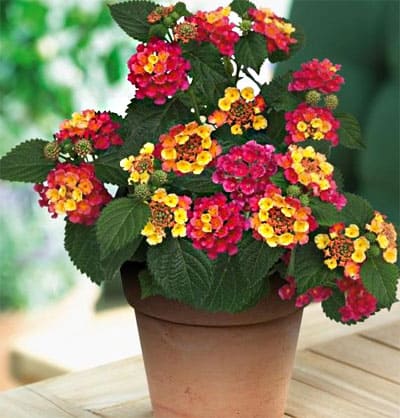

- Since lantana is a tropical plant, it can be grown in the sun and high humidity during the summer months. In the winter months, it is advisable to rearrange the bush on the windowsill and give it the required amount of light.
- In winter, the air temperature should not be more than +10 degrees, and the humidity required is normal for the room. At this time, the plant is resting and gaining strength.
- After the winter period, the flower must be transplanted into a new flowerpot and pruned. When transplanting, you need to remember that lantana does not need too fertile and nutritious soil, especially heavy. In such a soil, flowering will not be plentiful. Leafy soil and river sand must be added to the soil.
- It is necessary to moisten the soil when the top layer becomes dry. Do not allow the soil to dry out, as flowering will stop. At the same time, it is undesirable to flood the plants, as decay of the root system may begin.
- When the flowering period begins, then regular feeding in the form of complex fertilizers is required. Recommended as an option - Kemira plus.
- Lantana has good immunity to harmful insects. Little susceptible to their attacks.
- Experienced growers advise to rejuvenate the plant every 3 to 4 years, since the stems coarse and lignify, growth becomes less, and flowering is less abundant.
- After flowering, it is better to pick berries without waiting for them to ripen. This will save the plant's energy.
Features of growing lantana:
In room culture
Soil substrate from a mixture of sod land, humus, sand in a ratio of 1: 1: 1. Watering is plentiful during the growing season, but waterlogging should be avoided. They are kept on the windowsills of the southeastern and southwestern windows, in summer with a slight shade (lantana blooms only on the sunny side of the house). Lantana does not tolerate high summer temperatures with high humidity. For greater bushiness, the tops of the shoots are pinched. Every 2 weeks they are fed with full mineral fertilizer. Lanthanum pruning tolerates well, therefore, vigorous shoots are shortened in a timely manner. If necessary, in July, you can transfer to a larger pot, which will ensure more abundant flowering. For lantana, winter relative dormancy is important, in which it is placed in a bright place with an optimal temperature of + 12 + 14 ° C, watering is limited, but the soil is not allowed to dry out; when the leaves completely fall, it is kept at a temperature of + 6 + 8 ° C. Transplant in spring in March annually with pruning of weak shoots and pinching of the tops. Cut shoots are cut and rooted in wet sand (root easily).Practical advice If a whitefly attacked your lantana, which it attracts like a magnet, then for 2 weeks every day you need to wipe each leaf on both sides with a wet cloth. If the whitefly is heavily colonized, put the pot with the plant in a bag, after sprinkling it with a cockroach remedy, tie it up and put it in partial shade on an open balcony or loggia for a day, then wash the plant in cool water under the shower.
Lantana quite steadfastly tolerates the dryness of the premises, however, it can "surrender", and a spider mite and a scabbard will attack it, therefore, to prevent this from happening, it must be sprayed from time to time from a spray bottle with settled water at room temperature; at the same time, try not to get water on the inflorescences. When waterlogged, it can be affected by fungal diseases, and then it will have to be treated in the open air with fungicides.
In tub culture
It is grown in the same way as in indoor conditions, with the only difference that in the spring, after the threat of return spring frosts has passed, it is gradually hardened and taken out into the open fresh air. In the summer, they regularly water, feed, cut. In the fall, before the autumn frosts, cut it off shortly and bring it into a cold greenhouse with a temperature of at least + 6 + 8 ° C, water it occasionally. Practical advice If a whitefly attacked kadochnaya lantana in the fresh air, then it is necessary to move the container with it from the front place of the dacha to the "backyards" and treat it with Fitoverm according to the instructions. Spray the underside of the leaves with particular care.
In the open field
In the open field, lantana is grown on the Black Sea coast of the Krasnodar Territory. At the same time, the list of mandatory agrotechnical measures includes the following:
- shallow digging of the soil in the spring, followed by loosening;
- regular watering;
- mulching the soil with an organic substrate;
- top dressing (every year) in April, June, September;
- pruning during the growing season of long shoots that break out of the desired plant contour;
- pruning in the fall after the first frost on a "short stump";
- shelter for the winter with a thick layer of mulch.
If there are seeds that can be collected while traveling, they are sown in spring, before that they are soaked for a day in water at room temperature. Seedlings appear within 1 to 3 months at a temperature of + 18 + 24 ° C. Lantana is cut not only in summer, but also in February-March. Apical semi-lignified cuttings "with a heel", 10 cm long, with the removal of the lower leaves, are planted immediately into a loose moist substrate consisting of peat and coarse sand in a ratio of 1: 1 at a temperature of + 20 ° C. Rooting takes place within 3 weeks.
- Lantana in the New World in the 18th century. discovered by the Spaniards.
- In open ground, it grows today in Bolivia, Peru, Ecuador, Argentina, Chile, on the Black Sea coast of the Krasnodar Territory - in Sochi.
- Ambiguously perceive the smell of lantana leaves; some associate it with cat urine, others stuff them into sachets and cushions from dry lantana leaves and inhale, as they characterize, the tart, pungent smell of mint, camphor and onions.
- Due to the fact that lantana flowers, as they bloom, change color from white or yellow to orange, dark red, purple, it is called lantana in Germany, undergoing a change, in the Czech Republic - a girlish word.
- One flower blooms for 3 days.
- Unripe lantana fruit is poisonous and toxic to humans and animals.
- In Thailand, you can find multi-colored lanthanum standard trees when several different varieties are grafted onto one trunk.
- The medicinal properties of lanthanum have been known for a long time. So, the Spaniards used lantana camara when bathing in the baths, because she soothed them and even with various cuts, wounds, dermatitis, bites. A decoction of its leaves was used for a lazy stomach (as an analogue of modern motilium), rheumatism, and colds.In addition, it was previously used for snake bites, the treatment of paralysis, and malaria. Burned dry leaves have been used as a natural repellent for centuries.
Lantana kamara lubava
Lantana camara - a plant with "obedient" branches
Lantana camara is a name that is not known to all flower growers. One of the most amazing herb and shrub crops has earned many original nicknames - spiked nettle, girlish word, spiny colored nettle, rainbow bush... Disdainful "nettle" for this luxurious plant is not entirely appropriate. If lantana camara is capable of surprising something, it is spectacular.
Lantanus presumably received their botanical name in honor of the ancient Roman "viburnum", their inflorescences really slightly resemble the shields of viburnum inflorescences in shape, although lanthanum has much more in common with other members of the Verbenov family.
Lantana camara (Lantana camara) is the most famous and widespread species of the genus. Today, the species name is often not mentioned on the market, but if the plant is sold under the general name "lantana", we are talking about camara lantana.
Depending on the strategy of cultivation and formation, lanthanas can be in the form of compact bushes, sprawling pillows, neat or not very trees, but still they remain fast-growing plants with erect, densely branching shoots and woody, strong, densely branching roots.
Lantana grows rapidly and is one of the most active cold-resistant crops. Tetrahedral shoots woody slowly and branch surprisingly densely. Moreover, the more actively they are cut, the better young shoots grow. The plant develops rapidly, even after strong pruning at the end of February, already in April, the blooming plant is able to release the first buds.
The shoots of lantana camara are often spiny, not densely leafy with opposite leaves, but due to branching, long internodes are imperceptible.
The leaves of lantana are a bit like nettles, but they look more solid. A wrinkled surface, protruding relief veins, an oval leaf shape with an elongated tip is combined with a coarse or finely toothed, and sometimes serrated edge. On the shoots, the leaves are located on rather long petioles. The dull surface of the leaves appears velvety, also due to the unusual pubescence along the veins, which intensifies on the underside of the leaf blades.
Upon contact or rubbing, camara leaves exude a rather pungent aroma, which combines spicy, refreshing and unpleasant notes.
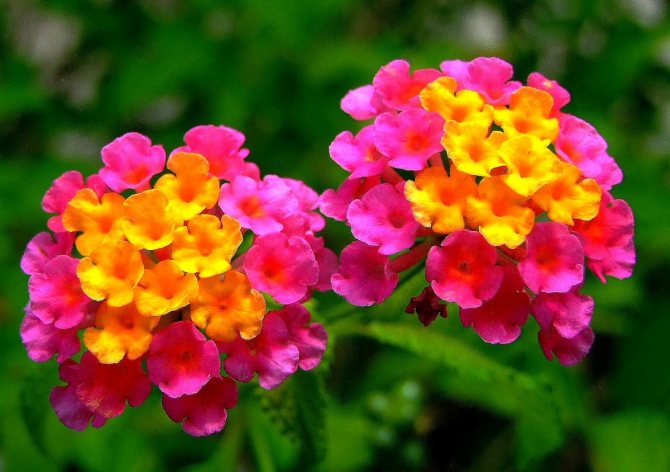

The ability to change colors distinguishes camara lantana from all other competitors.
Flowering lantana camara
Lantana camara blooms tirelessly throughout the summer. The inflorescences seem to open after each other, creating the effect of a continuous parade. The first buds appear on the plant by the end of April. The flowering of lantana, somewhat weakening, usually lasts throughout September.
The spherical shape of camara lantana inflorescences upon closer inspection is a simple shape of hemispherical dense scutes, but from a distance they look like ideal balls. Before the flowers begin to bloom, the inflorescences seem to be flat discs, quickly transforming when luxurious tubular flowers with a simple flat broom rise on long pedicels. The maximum diameter of camara lantana inflorescences is about 5 cm.
The ability to change colors distinguishes this plant from all other competitors. Of course, the "mechanism" of repainting on Camara lantana inflorescences is quite simple: the flowers change color to darker and more saturated as they age. 3 different colors change on one inflorescence. The effect of this is simply amazing.
Close in spectrum, but often different in character, light and bright tones seem to flow in watercolors into ever brighter ones in already blossoming flowers.And the plant seems to be iridescent - bright, original, multicolored.
Flowers bloom first along the edges of the inflorescence, so the color shades outside are always more intense. Only at the end of flowering, a few days after the last central flowers have bloomed, does lantana finally acquire a solid color. But it is worth taking a closer look at the flowers: inside each flower, subtle spots of other shades still remind of a watercolor rainbow miracle.
The color of lantana inflorescences in the classic version is yellow-orange-red. But the development of varieties with brighter colors and almost monochromatic variations changed the boring basic forms beyond recognition. And today, decorative forms of the plant, which were bred in the 19th century, remain very popular - mutabilis with a change from white to yellow, pink and purple, sanguinea with repainting of inflorescences from yellow to red.
Like the classic varieties Mixta with a "double" inflorescence of external yellow-cherry and internal yellow-orange flowers, white-blue variety Nivea and yellow-orange Crocea.
More modern varieties boast very large inflorescences. Gorgeous orange-terracotta-brick variety "Cocktail", yellow-white variety "Golden Cloud", yellow-orange-pink variety "The Pink Queen" - typical multicolor hybrids. Among the single-flowered varieties, the dazzling lemon color of the variety is especially fond of Lucky Lemon Cream.
Not all lantanas bear fruit abundantly, but basic plants and ornamental forms, like some old varieties, set seeds in large quantities. The berry-like fruit is highly toxic before ripening.


Lantana montevidensis (Lantana montevidensis). <>
Description, features, photo
Lantana came to Europe from Central America, botanists attribute this flowering perennial to the Verbenov family. It is a branched shrub with fast-growing erect stem shoots. It can grow up to 3 m in height and almost the same diameter. Basic varieties are fast growing, but modern bred hybrids grow slowly and are more modest in size.
The plant has a well-developed root system, which, in open ground conditions, goes into the deep layers of the soil. For tub and pot growing, this requires frequent replanting. A fast and chaotically growing crown - its regular correction. The bark is smooth, light green in color, some species have small stem spines.


The leaves are pubescent, short petiolate, ovate, with a serrated edge. They grow alternately, arranged in a spiral. In some varieties, the leaf plate may have a lighter color strip along the edge. In its thickness, glands are located, through which essential oil protrudes onto the surface of the leaf, exuding a peculiar pleasant smell, which is especially intensified when rubbed.
Due to the fact that lantana perfectly tolerates pruning, its bushes can be given various shapes and, if desired, adjust the height.
Landing
Lantana requires loose soil with good air and water permeability. For self-preparation of the mixture, you will need to use garden and leafy soil, coarse sand or perlite (all in equal shares). And also you need to add peat (30% of the total mass), which will retain water.
A pot that is too spacious is not required, as a small space for the root system stimulates the plant to bloom. It is best to take a light-colored ceramic pot 1–3 cm larger than the previous one. Lantana spends some time in the sun, so it is important that the pot does not overheat. Drainage is required at the bottom of the tank. It is recommended to replant lantana every year in April.
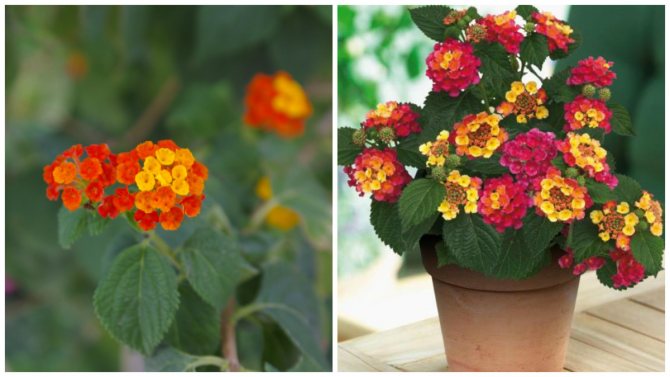

Lantana does not need a pot that is too spacious
Transplant process
- Fill a new pot with 3-4 cm drainage.
- Remove the plant along with the earthy clod. Shake off lightly.
- Place lantana in a new container, sprinkle with soil. When planting, the plant must be placed in a pot so that the top of the ground is flush with the root collar.
- The soil around the roots must be compacted.
Species diversity
Thanks to the painstaking work of breeders, many hybrid varieties have been bred, which have found wide application in floriculture. Among them, they are distinguished by their decorativeness:
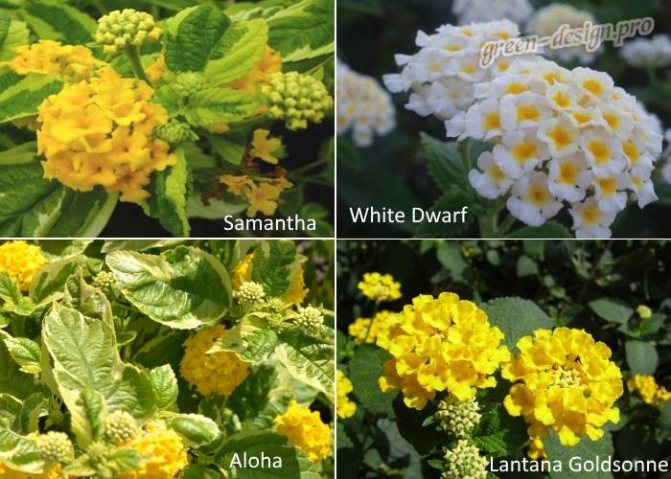

- White Dwarf - the variety is distinguished by large, terry flowers of a snow-white color.
- Samantha - has a bright lemon-yellow inflorescence shade.
- Aloha - has drooping shoots, light yellow inflorescences and variegated, bright leaves. It is widely used in container plantings.
- Goldsonne - blooms with yellow inflorescences, has creeping shoots.
Among the abundantly flowering varieties that are distinguished by a bright appearance, it is worth highlighting: Miss Huff, Silver Mound, New Gold. These varieties have exquisite colors, but do not bear fruit.
Biological role
In the 1930s, the Soviet scientist A.A. Drobkov investigated the effect of rare earth metals on cultivated plants. He carried out experiments with peas, turnips and other plants, introducing rare earth elements (REE) into the soil with boron, manganese or without them. Experimental results showed that rare earth elements, including lanthanum, improve plant growth. However, the use of micronutrient fertilizers based on lanthanum and other REE leads to opposite results for different species and even varieties of the same species of cultivated plants. In China, which is the world's leading producer of REE, such microfertilizers are widely used in agriculture.
Lanthanum ions are able to increase the amplitude of GABA-activated signals on pyramidal neurons of the CA1 gene, noted in the hippocampus of the brain. Obtaining these data made it possible to compare the sensitivity of the GABAA receptors of pyramidal neurons with similar receptors of other cells in terms of their susceptibility to GABA and lanthanum ions.
Typical mistakes of a novice florist
Most unintentional florist mistakes will not kill lantana. But they negatively affect its decorative effect. The plant may refuse to bloom altogether. This is the most obvious signal - he is not satisfied with something. But there are other alarming symptoms that need to be able to interpret.
Table: how lantana reacts to florist errors
| What does a plant look like | Than the reason |
| Lack of flowering. | Failure to provide the right conditions (especially temperature) during the dormant period, lack of nutrients in the soil. Or the flower has not been transplanted for a long time. |
| The leaves become smaller, turn pale, the shoots become thinner. | Lack of light. |
| The tips of the leaves turn brown, dry, the leaf plates curl into a tube. | Too poor watering and / or very low room humidity. |
| Pale spreading spots on the leaves. | Burn from direct sunlight. |
| The leaves turn black. | Abundant watering combined with low indoor humidity. The flower needs to be sprayed more often, and watering, on the contrary, should be reduced. |
| Leaves fall. | Autumn leaf fall is a natural phenomenon. During the active growing season, it can be triggered by heat or low humidity. |
| The bases of the shoots turn black, the soil is covered with mold. | Low temperature combined with high air humidity. The development of rot is almost inevitable. |
Bloom
The flowering period begins in May and covers the entire warm season until the beginning of autumn, with each flower living for no more than 3 days. Peduncles are removed from the leaf sinuses at the tops of the shoots. Inflorescences are spherical, with small tubular flowers with an intense aroma. A characteristic feature of the plant is its ability to change the color of the inflorescences as they open, which looks very impressive, since this happens at different times in different buds. The transition of shades occurs from light tones to darker, saturated ones. Thus, yellow lantana gradually turns into a rich orange.If the petals immediately had an orange color, then by the end of flowering they can turn burgundy-red. Thus, flowering lantana always looks different.
After flowering, fruits are formed, which are poisonous when unripe. Their toxic effect extends to both humans and animals.
Use of lanthanum
This bright long-blooming perennial will decorate a balcony, terrace, veranda or porch. Lush bushes with bright flowers will add a festive mood and color.
In the open field, planted in a flower garden, lantana looks good with geraniums, fuchsia, petunia. In single plantings, against the background of the emerald carpet of the lawn, it is also good.
In ancient times, Europeans used lanthanum as a medicine. A decoction of its leaves was added to baths to treat eczema, wounds, burns and bruises. Inside, the broth was taken for colds and sluggish digestion. And ash from lantana leaves is a natural and safe insect repellent.
Watch also a video on the topic:
Lantana fertilizers
At the time of the beginning of flowering and before the completion of this process, the flower requires feeding in the form of fertilizers. It is necessary to add them to the ground 2 times a month in an already diluted form.
FERTILIZERS FOR THE GARDEN AND GARDEN!
Epin extra: application of fertilizer for indoor plantsSuperphosphatePotassium monophosphateNitrogen fertilizer
Wherein organic and mineral fertilizers should be alternated with each other.
Any fertilizer designed specifically for flowering indoor plants is perfect for these purposes.
It is also not worth overdoing it in this matter. Excessive fertilization stops the growth of lantana.
How to care
Cissus flower. Description, features, types and care of cissus
Despite the fact that wild species of lantana grow in rather specific conditions, indoor and tub crops quite easily adapt to both home and garden content.
The rules of care are not so complicated as to refuse the content of lantana, the main thing is to observe some precautions. At home, lantana will feel good near windows facing the south, southeast, southwest sides
In the hot season - if at night the temperature does not drop below + 18-20C - you can take it out to the balcony, loggia, veranda and even to the garden. The main condition for placement is the absence of drafts. The constant supply of fresh air encourages the growth of shoots and lush blooms.


Watering should be abundant and regular. Do not allow both excessive drying of the soil and excessive overflow. Lack of moisture can lead to the discharge of foliage, and its excess can lead to decay of the roots. In the active period of growth and flowering, lanthanum needs spraying, but this must be done extremely carefully, to ensure that water does not fall on the inflorescences. To maintain optimal humidity, you can install a container with a flower in a special tray with wet expanded clay.
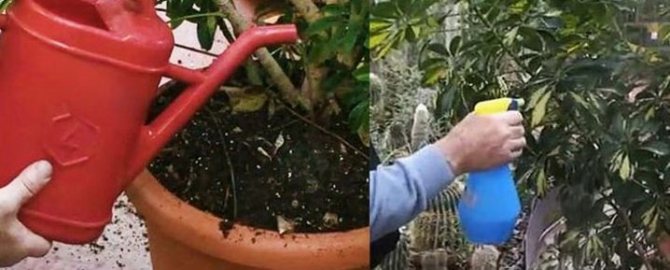

In the spring-summer period, lantana must be fed and this must be done at least once every two weeks, but not more often, otherwise, instead of lush flowering, shoots will grow vigorously. You can use any universal fertilizer for houseplants, but the single dose of the drug should be reduced by 2 times. In the preparatory period, you can feed the plant with your own prepared fertilizer, which is based on cow dung mixed with water in a ratio of 1: 14. In winter, when the plant is in a dormant period, you do not need to apply additional fertilizing.
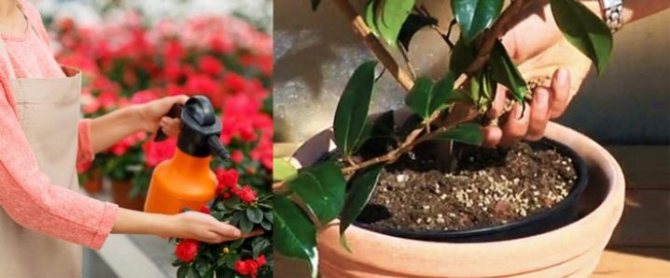

Plant pruning must be done during the preparatory period The old side stems are cut off, which remained in the lower part without foliage. On the rest of the shoots, the pinching procedure is carried out - it is enough to remove the 2 upper buds and the enhanced development of young lateral shoots is ensured, and with them a lush flowering.With the help of pruning, you can give the lantana crown almost any shape and grow not only a healthy plant, but also an aesthetically attractive one.
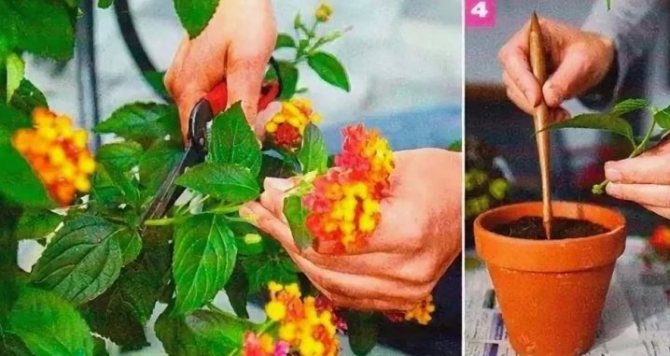

Medicinal properties of lantana
Traditionally, lanthanum of the verbena family belongs to plants with excellent medicinal properties. Previously, it was actively used in the treatment of serious ailments such as malaria, paralysis, or even a snakebite.
The Spaniards use lantana to combat skin lesions: cuts, bruises, wounds and dermatitis.
For stomach pains, colds viruses and rheumatism, a decoction of lantana leaves was taken. Dry leaves served as a repellent.
At the same time, it is important to remember that lantana fruits in a state of immaturity are toxic and pose a threat to the health of both people and their pets.
BEAUTIFUL FLOWERS!
Nerine flower or spider lilyWeigelaHydrangea
Care
This southern beauty is completely picky, but appreciates care and attention and reacts sensitively.
Lantana grows best in bright light and long daylight hours. Therefore, the south side is more suitable for keeping the plant. In the summer, the flower is taken out into the garden. There, lantana feels great, increasing its green mass and delighting with lush flowering.
The plant calmly tolerates direct sunlight even in the scorching heat. In the shade, the plant is less comfortable, the leaves become smaller without the sun, and the flowers become scarce.
This thermophilic plant thrives in hot climates. In this case, you only need to water the lantana more abundantly.
In warm winters, the bush is grown in the open field. When grown at home, the most suitable temperature will be 22-27 degrees. In winter, to keep the plant, the air temperature drops to 10-12 degrees. There are varieties that can survive a short-term drop in temperature to -2 degrees.
An artificial increase in humidity is not required for the content of lanthanum. She is quite comfortable in a city apartment. But if you wash and spray the leaves, the plant will feel it.
When spraying during flowering, water on the inflorescences will cause the flowers to wilt.
Regular watering is very important for lantana. If there is frequent drying out of the soil, then the leaves of the plant wither and the plant may stop growing. In this case, buds that did not have time to bloom may crumble. It is necessary to water the plant as the top layer of the soil dries out, using warm and settled water for irrigation.
It is necessary to feed the plant throughout the growing season until flowering. Fertilize the soil in a pot twice a month, alternating fertilizer complexes.
To improve decorativeness, you should quite often pinch the plant and prune the bush. With proper pruning, you can achieve the formation of a beautiful tree with a magnificently blooming crown.
Possible diseases and pests
Solar lantana does not tolerate cold and dampness. In a too humid and cool room, the plant can get sick with leaf rust.
Excessive watering and stagnant water in the roots leads to root rot.
It is imperative to monitor the conditions for keeping the plant, not forgetting to loosen the soil in the pot. A diseased flower must be completely cut off, and then treated with a fungicide.
Lantana leaves are attacked from time to time by various insect pests, especially in the open field. Therefore, in the spring it is necessary to carry out preventive treatment.
What does lantana look like
Lantana (Lantana) is a genus of perennial plants that belongs to the Verbenaceae family. It is widespread in South and Central America, some species are found in Africa and Southeast Asia. According to various sources, the genus has from 140 to 170 species.


Lantana grows very quickly in nature.
The name of the plant was given by the famous Swedish taxonomist Karl Linnaeus. The ancient Romans called the viburnum "Lantana".Apparently, the botanist's choice was influenced by the characteristic corymbose shape of the inflorescences.
Indoor plant lovers appreciate lantana for its unusual flowering. In addition to the fact that it is long (from April to October), the petals gradually change their hue. This happens literally before our eyes, within 2-3 days. At the same time, on the bush, you can see scarlet, orange, bright yellow, white flowers. They are collected in numerous dense inflorescences in the shape of an umbrella or an almost regular ball. A pleasant aroma is characteristic. If lanthanum is light enough, it can bloom continuously almost all year round.
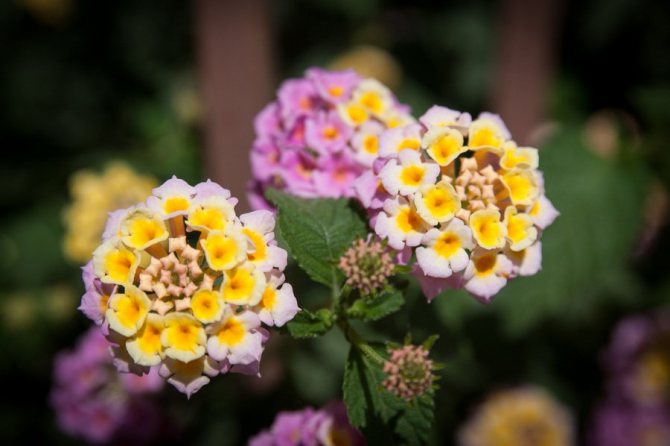

Lantana inflorescences in the form of an almost regular ball
After flowering, small rounded berries appear, each with two seeds. Unripe fruits are green, they cannot be eaten, they are poisonous. Ripe berries, where lantana grows, are eaten, most often added to various desserts. The taste is reminiscent of mulberry.
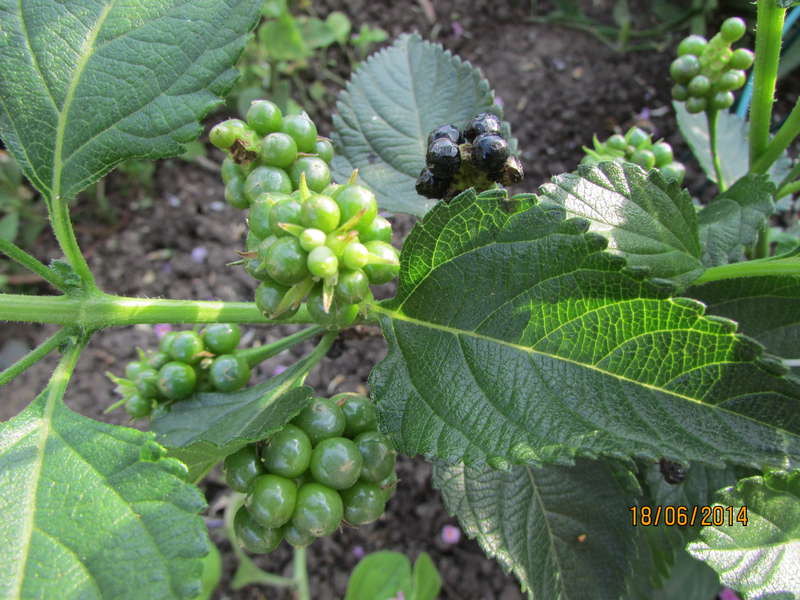

Unripe lantana fruit is poisonous
The plant branches intensively. In nature, it is a shrub or tree, reaching 3 m in height. Lantana is distinguished by its growth rate, so it needs regular pruning at home. It can be shortened to about a height of 30-50 cm. Shoots are covered with smooth greenish-gray bark, sometimes with frequent thorns.
The opposite leaves are slightly pubescent. The average length is about 4–5 cm. To the touch, they are rather hard, rough, as if they were made of plastic. The leaves are shaped like nettles. The edge is similarly carved with teeth. The veins are clearly marked.
The leaves also spread a specific tart aroma that not everyone likes. It has hints of mint, lemon, camphor, and some feel the onion "amber". For it to spread throughout the room, a light touch of the flower is enough. However, others really like the smell. Dry lantana leaves are even used to make sachets.
Lantana leaves are also pretty, but this is not the main advantage of the plant.
The leaves are also not very pleasant to the taste, they give off bitterness. The plant secretes a special toxin that covers them with a thin film. This feature reliably protects lantana from the encroachments of pets.
In countries where lantana is not endemic, this is a real disaster. It grows very quickly, assimilating new territories and displacing the local flora. States are forced to take harsh measures against the foreign "invader". For example, in Australia and South Africa, it is officially forbidden to plant lantana in parks and gardens, even private ones.
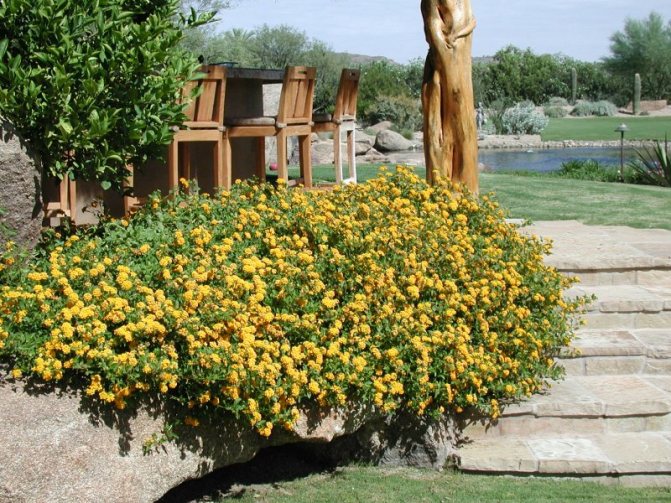

Where the climate permits and where it is not prohibited, lantana is widely used in landscape design.
Lantana has many nicknames. It is called "nettle" (for the characteristic shape of the leaves), "girlish word", "changeable rose", "switching flower" (for "inconsistent" color), "fried eggs with bacon", "Spanish flag" (for a similar color scheme) ... Other unofficial names are “coastal rose”, “great sage”, “little berry”.
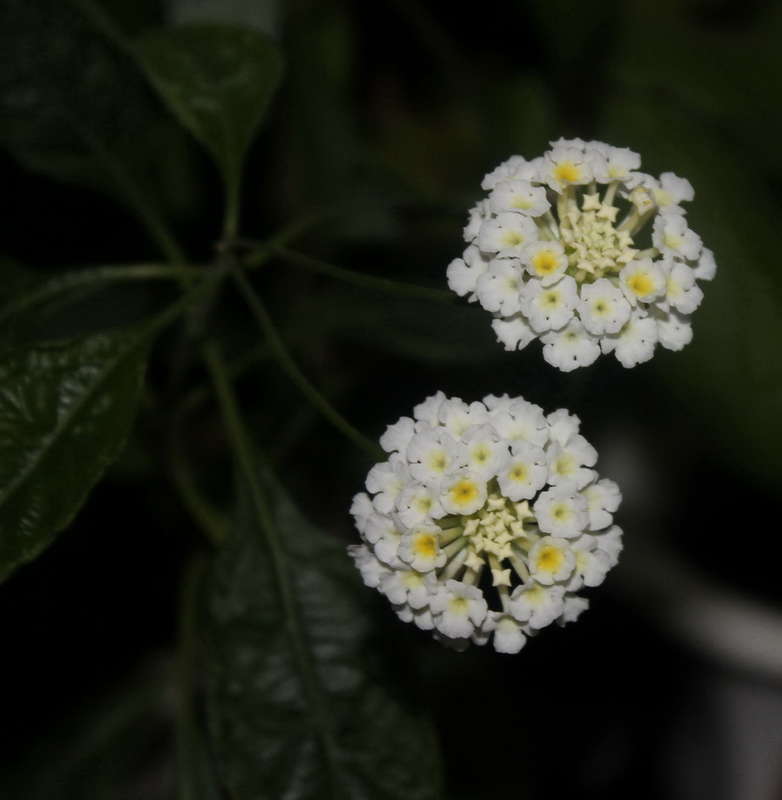

Lantana petals change color literally before our eyes
Growing a lanthanum flower from seeds
Lantana seeds photo
- For flowering to begin in May, lantana seeds should be sown at the end of February.
- You will need wide containers (any plastic container is used) and a loose nutrient mixture (most often they take a universal substrate for growing seedlings).
- Lay a layer of drainage on the bottom of the container, then add soil, level and moisten, distribute the seeds evenly over the surface and lightly sprinkle with earth.
- In order not to suffer later with a pick, it would be better to plant 1 seed in separate cups or cells of seedling cassettes.
- In the future, use a fine spray to avoid flooding the seedlings.
- Crops will need warmth (around 20 ° C) and bright, diffused lighting.
- In addition, it is recommended to cover the container with crops with glass or transparent film, but ventilate daily to prevent mold.
- Under these conditions, seedlings will appear after 14 days.
- The shelter can be removed, continue with moderate watering.
- When the seedlings grow up and drive out 2-3 true leaves, cut them into separate containers.
- Plants grown in cups and cassettes are transferred to a permanent pot.
Pinching and pruning lantana: how to get a beautiful and lush plant
In the spring, when the plant passes from the dormant stage to the stage of active growth, it is necessary to carry out the procedure for pruning its shoots and pinching them, as well as removing already faded inflorescences.
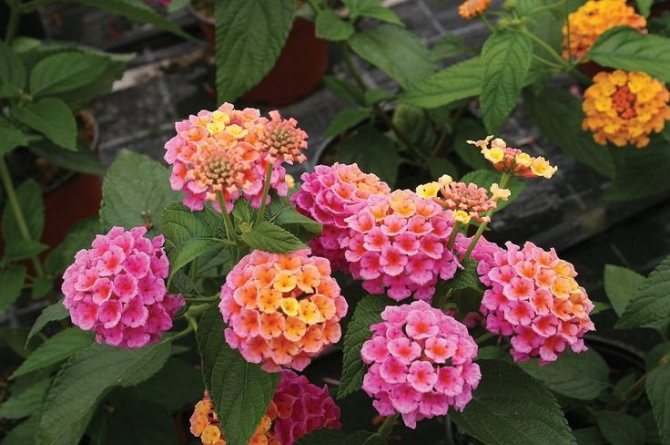

These procedures will help to create the most beautiful crown of the plant, thick and luxuriantly blooming. Usually, with proper pinching, there are so many flowers in lantana that leaves are completely invisible behind them.
In addition, with the help of these simple manipulations, you can acquire a tree of the shape that is closest to the owner of the lantana:
- standard tree;
- ball;
- ampelous flower.
Useful article:
How to improve the soil, its fertility, composition, structure
Shrub description
- The flowers of the plant converge into rounded corymbose inflorescences. The main advantage is the very long and abundant flowering process.
- At the same time, the cultivation of lantana is not difficult, the plant is unpretentious, has compact forms. One of the top 10 crops for tub cultivation in the south of our country.
- Despite the pros, there are nuances that must be paid attention to. Hybrid lanthanum is a breeding form. Such species are most common in the society of gardeners. They have good decorative properties.
Pests, diseases
If agricultural technology is violated, lantana can be affected by rot, mold and rust. The plant is treated with fungicides, and to prevent diseases, the soil is regularly loosened, watering is carried out only with warm water, and lantana is not allowed in a cold room.
In the open field, lantana is often attacked by whiteflies, aphids, scale insects, and spider mites. With a weak infection, the plant is washed with soapy water, simply washing off the pests. In case of severe damage, the plantings are sprayed with Aktara.
Diseases and pests of lantana
Lantana is practically not susceptible to diseases, but it can sometimes be attacked by insect pests.
Table: pests of lantana and methods of dealing with them
| Pests | Symptoms | Prophylaxis | Control measures |
| Spider mite | Small red insect that forms cobwebs on plant parts. The plant dries up. |
|
|
| Whitefly | Small butterflies that leave a sticky coating on the leaves. It becomes a habitat for the sooty fungus. |
| |
| Shield | Small brown plaques on the leaves. |
|
Photo gallery: lantana pests
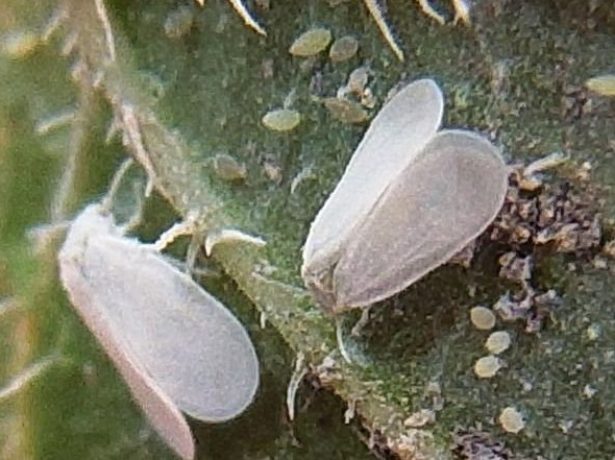

Whitefly causes a sooty fungus to appear
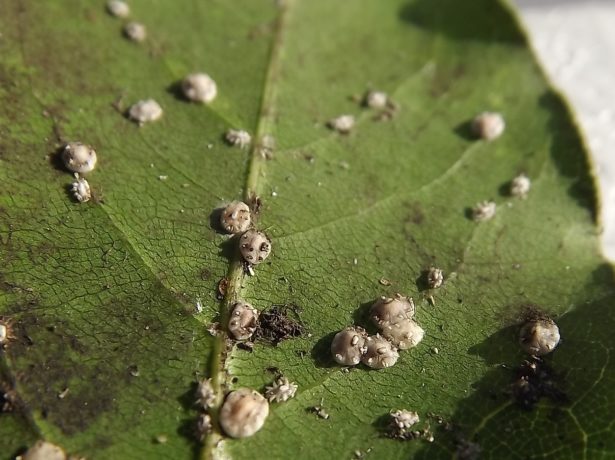

Small scale insects will help collect kerosene or vinegar


Mite enmeshes leaves with cobwebs
History of appearance
Lantana is a plant that came to Russia from Latin America. For its ability to grow rapidly, it received the nickname "the curse of the planters."Beautiful shrubs with fragrant buds literally occupied the land intended for planting other crops. But in the gardens they did not fight against the dominance of shrubs, on the contrary, they planted it with pleasure.


Blooming lantana
Lantana was first described in 1737 by Carl Linnaeus in his work "Genera Plantarium". The scientist gave the flower the same name as by that time the shrub Viburnum Gordovina bore (the plants have very similar inflorescences).
Interesting to know! Due to the external similarity of lantana leaves with nettles, the shrub is sometimes called nettle among the people.
History
Lanthanum as a chemical element could not be discovered for 36 years. In 1803, 24-year-old Swedish chemist Jones Jakob Berzelius investigated a mineral now known as cerite. Yttrium earth and another rare earth very similar to yttrium were found in this mineral. She was named cerium. In 1826, Karl Mozander investigated the cerium earth and concluded that it was heterogeneous, that in addition to cerium, it contained another new element. To prove the complexity of the cerium earth, Mozander succeeded only in 1839. He was able to isolate a new element when he had more cerite at his disposal.
Lantana disease and other growth problems
Lantana can be attacked by fungal infections if not cared for properly. Most often, its leaves are affected. They dry out, become stained, wither or fall off. Preparations will help - fungicides, with which it is necessary to spray the diseased plant after removing the parts affected by the disease (leaves, shoots) from it.
- Excessive watering of the plant in a cool room can lead to decay of the root system. In this case, remove the flower from the pot, inspect the roots, cut off the rotten ones. Sprinkle the crushed charcoal over the slices. Also remove affected leaves and shoots. Place the flower in another pot with fresh, loose soil. Treat it with some kind of fungicide. Create the right conditions for Lantana to grow normally. If this happens in winter, keep the flower cool with moderate watering and good lighting.
- If the Lantana shoots are stretching and the leaves are getting smaller, check the light level. It may be necessary to rearrange the plant in a place more illuminated by the sun or arrange additional artificial lighting.
- If the edge of the leaves begins to dry out, and the top curls, then the air in the room is too dry. It is necessary to raise the humidity level. Start spraying the air around Lantana, place the pot in a pan with damp pebbles or expanded clay.
- If Lantana does not pick up buds in spring, then this may be for three reasons: either insufficient lighting, or too large a pot in which the root system has not yet mastered the entire space, or the plant did not have a cool wintering the day before. Fix what is possible and wait for flowering.
- If the branches stretch out and the leaves become faded, the flower may be lacking in nutrients. Think back to the last time you fed the plant. Perhaps it's time to feed him again with organic matter or complex mineral fertilizer for indoor flowers.
- If Lantana begins to shed flowers and buds that have not yet blossomed, check the humidity and heat indicators in the room, as well as the regularity of watering and the quality of the water.
- If beige spots appeared on the leaves, covered with a layer of grayish pile with small black blotches, Lantana fell ill with gray rot. The leaves are likely to fall off, the buds will turn black and also fall off. Remove the affected parts. Treat the plant with a solution of Tsineb or Horus. For a month, water it with warm water with the addition of Skora or Topaz.
Pests
Whiteflies, mealybugs, spider mites, aphids and scale insects love to feast on the juice of the succulent foliage of Lantana. Their attacks are especially possible during the summer residence of the flower in the open air.We recommend to carry out preventive treatment of the plant in the spring with some kind of preparation - an insecticide against sucking parasitic insects. You can buy insecticides at any specialty store. Aktellik, Aktara, Fitoverm and many others will do.


If you missed this event, and then found insects or traces of their activity (the leaves were covered with a powdery bloom, cobwebs appeared on the back side, the leaves became sticky and stained), then Lantana needs urgent help. Pest insects are highly prolific and insatiable. In a short time, they will spoil not only the appearance of the flower, but also undermine its health. The leaves and buds will fall off, the stems will become bare, the sap movement in the plant tissues will be disrupted. The plant may die altogether.
If the lesion is not large, you can remove the parasites from the leaves with a cotton swab moistened with a solution of laundry soap (20 g per 1 liter of water). If there are a lot of insects, rinse them in the bathroom with warm water using a shower. After that, spray the flower with Aktara or Fitoverm, that is, with some kind of insecticide. You cannot cope with insects at once - see the instructions for the preparation and carry out the treatment as many times as necessary.
Views
Indoors, only two types of lantana are bred. More than 150 are known in nature.
| View | Description | Variety | Blooming period |
| Camara (vaulted) | The stem is twisted, covered with thorns. Leaves are gray-green, oval. The top is smooth or rough, the bottom is covered with pile. |
| Tubular, collected in inflorescences. The color yellow turns to orange, pink to red. From early May to late August. |
| Montevideo (Selloviana) | Branches weave along the ground. The leaves are small, green, ovate. | None. | Small. The color is purple, pink. They form a shield in the inflorescence. June to October. |
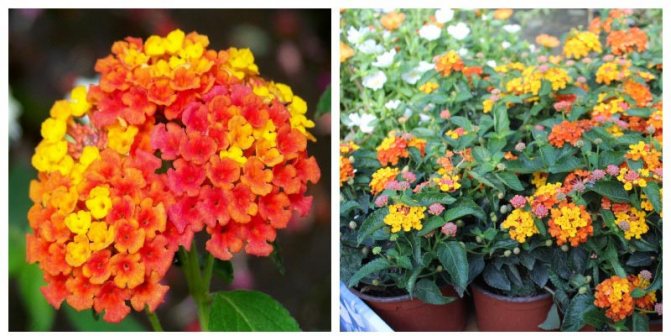

Kamara
Beautiful flowering weed
Surprisingly, in many southern countries, lantana is not only not grown for the sake of beauty, but they are struggling with it in all available ways. This is due to the rapid growth of this shrub and its aggressiveness towards neighboring plants. In India it is called the "curse of the planters", the landowners of Australia consider it one of their first enemies, and in Tanzania this flower is of great concern because its thickets are a breeding ground for malaria mosquitoes and tsetse flies, no less dangerous to human health.
Dormant period
Lantana is a perennial with a mild dormant period. She does not always drop leaves for the winter, but requires certain conditions for winter maintenance. They are provided with a cooler temperature, cessation of feeding, and a reduction in watering to moderate maintenance. The place where the flower stands should still be light.
If lantana has dropped its foliage for the winter, you should not be upset. Thus, she herself regulates the most comfortable state for her winter rest.
Varieties of lantana with a photo
In the wild, the plant is represented by 1.5 hundred varieties, while there are only two options for home breeding. On their basis, many varietal rows and hybrids have been obtained.
Lantana Camara
The main species used in culture. It is a perennial shrub of medium height (about 1.5 m) with erect or slightly curling stems, which at a young age have a herbaceous structure, and then gradually woody. Small but sharp thorns are present on the shoots. The foliage is tough, rough in the lower part due to fine pile, oval-heart-shaped. Lantana Camara blooms variable (changeable), like other types of culture. Tubular flowers gradually change their color from yellow or pink to orange or deep red. Lantana Camara is also described under the names Vaulted or Thorny. On the basis of this species, many decorative varieties and hybrids have been bred.
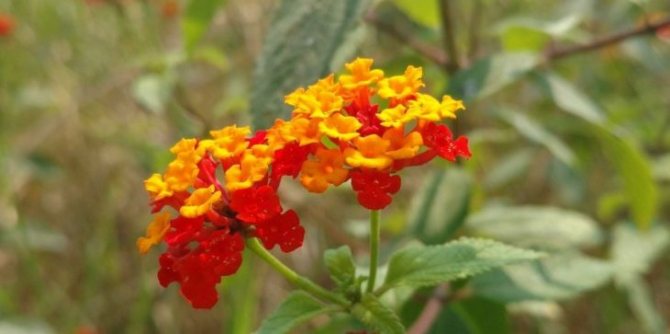

Lantana Montevideo
A smaller-leaved species with shoots creeping along the ground. Globular inflorescences are also smaller, no more than 3 cm in diameter. Their color is varied, but more often you can find flowers in pink-violet and lilac tones than white or yellow-orange ones. This species is grown less often than Camara lantana, but it is no less valued for its decorative properties. Blooms a little later than her in early summer.
The best varieties with photos
- "Golden Cloud" - inflorescences in a yellow palette from light lemon to deep dark yellow.
- "Cocktail" - from yellow and orange, the transition to red-terracotta is gradually being carried out.
- "Naida" is a variety in which breeders have managed to move away from the innate monochromaticity of the flower. The buds are snow-white in color with a light yellow core.
- “Pink Queen” is a very bright and contrasting transition from pale yellow to rich salmon color.
- "Aloha" is a variety for container cultivation with drooping ampelous shoots and variegated yellow leaves.
- Miss Hoof is a sterile hybrid that produces abundant orange-coral flowering without fruiting.
In Thailand, lantana is often grown in the form of a standard tree.
Transplant procedure
Since lanthanum has a different growth rate, transplanting for it is an annual procedure. The best time for this is early spring, before the start of the active growing season. If you do not pick up a voluminous pot or tub, a powerful root system can fill the container and in less time, the plant will need to be transplanted "off schedule". Clearly indicate that the need is ripe, roots sticking out of the drainage holes. If the unambiguous signal is ignored, lantana simply won't bloom.
The plant does not make special demands on the quality of the soil. The main thing is that it is sufficiently loose, that it allows air and water to pass through well. The acid-base balance is neutral - pH 6.6–7.0. Store-bought soil for flowering indoor plants is quite suitable. Sometimes there is also a special soil for Verbenovs, but rarely.
You can mix the substrate yourself:
- fertile turf, leafy soil, humus, fine sand (2: 4: 1: 1);
- peat chips, universal soil for flowering indoor plants, coarse river sand or perlite (1: 2: 1);
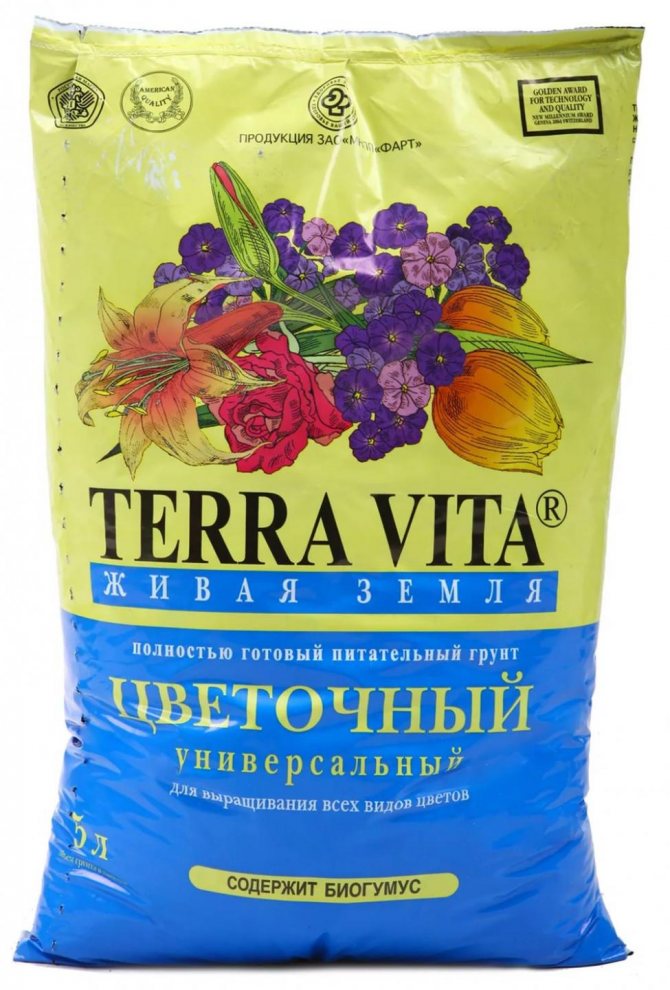

It is rather difficult to find special soil for Verbenovs, but lantana is also suitable for a common substrate for flowering indoor plants.
If it is difficult to transplant lantana due to its size (it is difficult to remove the plant from the pot), limit yourself to replacing the top layer of the substrate 5-7 cm thick. In other cases, the transplant is carried out by the transshipment method, the earthen lump, if possible, remains intact.
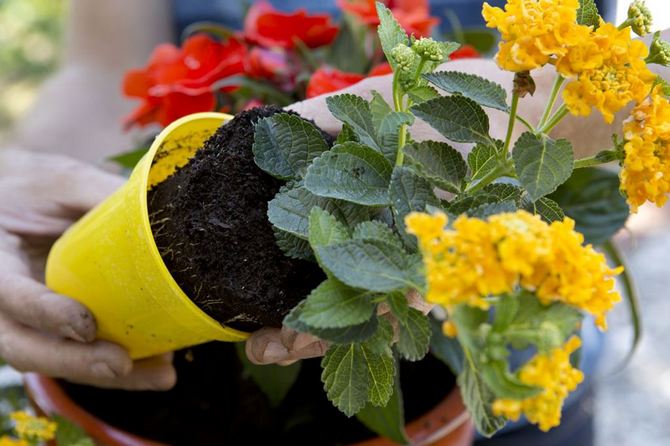

Lantana is easier to remove from the pot if you water the plant abundantly half an hour before.
In the process of transplanting, do not forget that at the bottom of the new pot you need to create a thick (4–5 cm) layer of drainage and cut off with a sharp clean knife 2–3 mm roots that have fallen down into a continuous “pile”. The transplanted lantana is watered moderately and sent to light partial shade for 3-5 days in order to minimize the stress received by the plant.
Experienced growers recommend planting 2-3 lantana bushes in one pot. Firstly, if they are of different varieties, such multicolor looks very elegant and original. Secondly, for some unknown reason, this stimulates branching - the plants increase in volume by 1.5–2 times.
Mr. Dachnik recommends: transplant
The lantana root system develops quite quickly and requires regular transplantation. Young plant - once a year, older - once every 2-3 years. The pot for the transplant is chosen to be roomy, wide, deep. The bottom is covered with permeable drainage (expanded clay, pebbles).
When transplanting, the roots of the flower are cleaned of old soil to obtain useful nutrients from the new one. For the substrate, mix in a ratio of 1: 1: 3: 4: humus, sand, turf, leafy ground.
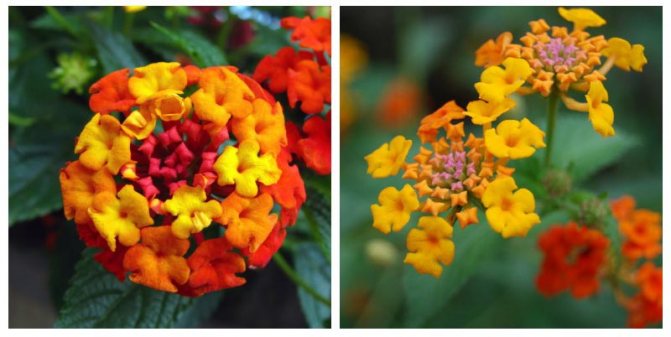

Camara (vaulted)
Plant care in the garden
If lantana grows in the garden, outdoors, it needs to be regularly watered, as drying out of the soil threatens the death of the plant. Lantana grows quite quickly, and very soon after transplanting into the soil, it will begin to bloom. If, as a result of improper care, poor quality, or for some other reason, wilting and drying flowers are found in the inflorescence, they should be carefully removed so that the plant itself does not waste its resources on them. It is advisable to remove flowers before they begin to bear fruit.
Regardless of the quality of the soil, the plant must be fed with mineral fertilizers. This should be done once a month, but if the soil is poor and not fertile, top dressing can be done every two weeks.
In general, this plant is easy to grow and easy to care for, but sometimes this flower is affected by pests. As a result, the plant may die.
Among the pests, lantana has one serious enemy - the spider mite (although other mites and beetles can also appear on the plant). This can be easily avoided by regularly spraying lanthanum with insect spray and insecticidal soap.
The plant does not tolerate cold weather, and if it feels comfortable in the warm season, then in winter it needs to be provided with appropriate care. Plants that are not planted in the soil and grow in pots or baskets, but are outside, should not be left in the cold. For these baskets and pots, it is necessary to arrange special greenhouses, which will become a kind of winter garden.
Read the basics of growing and caring for Gatsania, the timing of planting a flower.
Find out https://enn.imadeself.com/komnatnyie-rasteniya/shhitovka-na-komnatnyih-rasteniyah-kak-borotsya.html methods of dealing with scabbard on indoor plants.
The greenhouse should be located in a lighted area, and it is necessary to maintain the optimal temperature in it + 6- + 10 degrees. Such conditions can be achieved in several ways - from electric heaters to air heating.
Watering during this period should be reduced to a moderate level, as lantana uses less water in winter. If such conditions are achieved, lantana will survive the winter well and will not shed its leaves.
It is possible to take out lantana from the greenhouse in the spring, when the air begins to warm up, while the shoots of the plant must be cut off by about one third. Very soon, the plant forms new shoots, and after some time, flowering will begin: the plant very quickly rehabilitates itself after wintering.
Seasonal care and wintering
How to care for a plant during hibernation and wintering? At this time, it is best to move the container with the plant to a cooler place. The temperature there should be slightly lower than usual. After a few days, lower it by another couple of degrees. Having reached the level of 10..15 degrees, it is necessary to leave the plant until spring.
From time to time it will be necessary to water the soil so that overdrying does not occur. Spray and air around the pot. Observe the light regime (6-7 hours a day).


